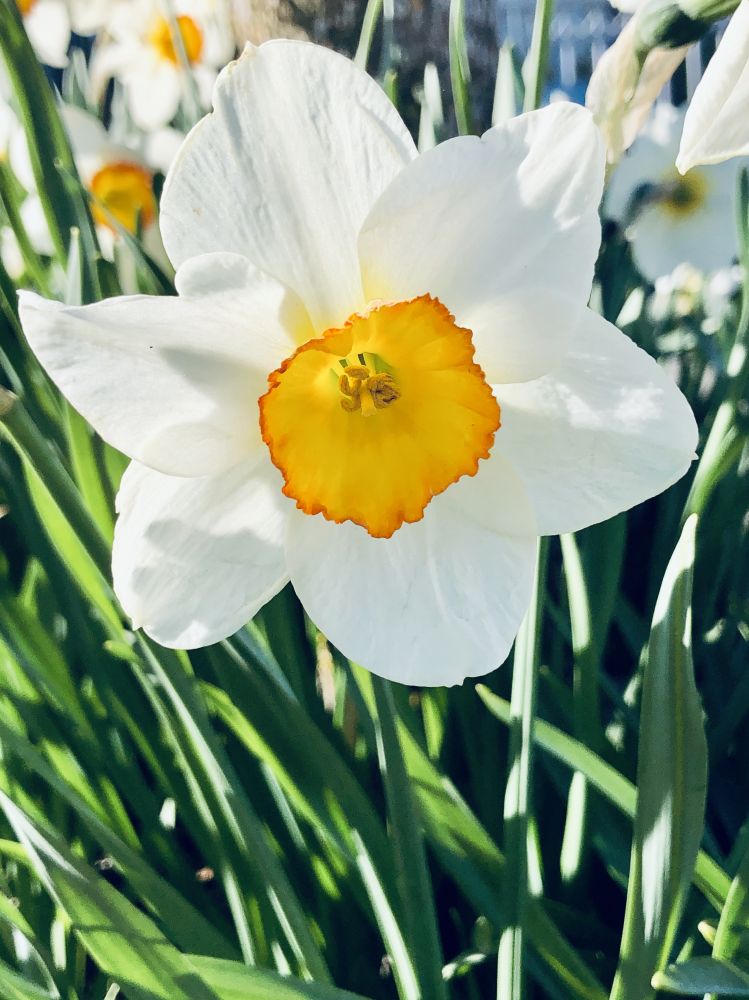盛开在油墨香里的水仙花:命运之花
(三)古希腊文学作品里的水仙花
出现在希腊神话里的水仙花到底是哪些品种呢?
西方专家们认为最大的可能性是红口水仙(Narcissus poeticus,俗名poet's narcissus,诗人的水仙),其次为多花水仙(Narcissus tazetta)。


(红口水仙)
红口水仙原产法国至土耳其一带,株高40-55厘米,四月开花,花单生,花色洁白,副冠呈浅杯状,黄色,杯的边缘为橙红色皱边,故名“红口水仙”。花香怡人,从中提取的精油可用来制作香水。
多花水仙原产于从葡萄牙至土耳其一带的地中海地区,是个头最高的水仙之一,可达80厘米,每球有花葶数支,多者可达10余支。每葶数朵至10余朵花,组成伞房花序,花瓣洁白芬芳,有黄色杯状的副冠。中国的水仙花就是多花水仙的亚种(Narcissus tazetta subsp. Chinensis),唐朝时从意大利引进的。


(多花水仙)
长久以来,水仙花是一种美丽的装饰花卉,古埃及的坟墓里和意大利庞贝古城残余的壁画上都出现了多花水仙。从《荷马史颂》里的《致得墨忒耳》篇关于水仙花的描述来看,用来引诱珀耳塞福涅的很有可能是多花水仙,因为“从它的根部长出一百朵花”,符合多花水仙的特征。许多专家认为纳西索斯死后化成了红口水仙,后世歌咏纳西索斯的诗篇很多,因而该水仙又被称为“诗人的水仙”。
古希腊诗人斯塔西诺斯(Stasinos)在他的史诗《库普里亚》(Cypria)(大约创作于公元前七世纪末或六世纪)提到了水仙花: “她穿着上天和时光为她做的衣服,用春天的花染色-这些花作为当季的着装-番红花、风信子、蓬勃的紫香堇和可爱的玫瑰花,如此甜美可口,还有美妙的鳞茎花卉,水仙和百合。阿佛洛狄忒(即爱神)一年四季穿着这种香气浓郁的服装。”
(She clothed herself with garments which the Graces and Hours had made for her and dyed in flowers of spring -- such flowers as the Seasons wear -- in crocus and hyacinth and flourishing violet and the rose's lovely bloom, so sweet and delicious, and heavenly buds, the flowers of the narcissus and lily. In such perfumed garments is Aphrodite clothed at all seasons)
古希腊剧作家索福克勒斯(Sophocles,公元前497年-公元前406年,古希腊悲剧的代表人物之一)在作品《俄狄浦斯在科罗诺斯》(Oedipus at Colonus)写了一首与水仙花有关的歌:“而且,水仙以天上的露水为食,美丽的花簇朝朝开放。它是两位伟大女神的古老王冠。 番红花绽放着金色的光芒。基菲索斯河川流不息,每天奔过大地胸前,用清泉灌溉平原,使土地肥沃。跳舞的缪斯不会离开这个地方,那个手持金色缰绳的阿佛洛狄忒也不会厌弃。”
(And, fed on heavenly dew, the narcissus blooms day by day with its fair clusters; it is the ancient crown of the Great Goddesses. And the crocus blooms with a golden gleam. Nor do the ever-flowing springs diminish, from which the waters of Cephisus wander, and each day with pure current it moves over the plains of the land's swelling bosom, bringing fertility. Nor have the dancing Muses shunned this place, nor Aphrodite of the golden rein.)
索福克勒斯以水仙来隐喻生育力,并将它同得墨忒耳和珀耳塞福涅两位女神联系在一起。因珀耳塞福涅是冥后,水仙又象征着死亡。 近代著名的希腊语教授理查德.杰布(Richard Claverhouse Jebb,1841 – 1905) 曾经这样评论:水仙是死亡之花,它的香气有麻醉作用,以淡白为主色。就像珀耳塞福涅伸手摘水仙预示了她的厄运一样,纳西索斯凝视着自己的倒影预示了他的死亡。
古希腊诗人莫斯霍斯(Moschus,约活动于公元前2世纪前后)流传至今的《田园诗》(Idylls)里,我最熟悉的是《欧罗巴》(Europa)一节。欧罗巴是美丽的腓尼基公主,与一群姑娘在长满鲜花的草地上玩耍。宙斯化身一头漂亮的小公牛,把欧罗巴劫持到克里特岛为所欲为。诗中是这样形容宙斯诱骗欧罗巴的情形的:
“现在,女孩们一来到开花的草地,立刻喜欢上了各种各样的花,其中一个女孩摘了甜香的水仙,一个女孩采了风信子,一个女孩采了紫香堇,还有一个女孩采了匍匐百里香,草地上落着许多带着春天气息的花瓣。其他人又在竞相收集着黄色番红花芬芳的毛发(即花柱头)。但是在她们中间,公主像绯红的玫瑰那样光彩照人,又像从泡沫里诞生的女神一样艳压群芳。的确,很长一段时间她都没有将心中的喜悦放在花朵上,是的,也很长一段时间都没有碰过她的少女腰带。确实,克罗诺斯的儿子一见到她就心动了,他的心突然被塞浦路斯女神的杖柄控制住了,只有塞浦路斯女神才能征服宙斯。因此,为了避免善妒的赫拉的愤怒,并急于欺骗少女的一颗纯真心,他隐瞒了自己的神格,换了形象,变成一只公牛。不是那种在牛圈里吃食,劈沟拉犁的牛,不是那种在草地上吃草的牛,也不是那种被束缚于轭下、拉着沉重车子的牛。不,尽管他的身子是亮栗色的,但眉毛之间有一个亮银色圆圈,他的眼睛微微发亮,闪现欲念之光。从他的额头上伸出均匀的长角,如有角的月牙似的,就像月亮被劈成了两半。他来到草地上,所有的姑娘们都不感到害怕,而是激起了接近这头可爱的公牛并触摸他的渴望,他天堂般美妙的香气散布在远处,甚至超过了草地上的花草香。然后他站在漂亮的欧罗巴面前,一直舔着她的脖子,向她施咒。她依旧爱抚着他,用她的双手轻轻擦去了他嘴唇上深沉的泡沫,亲吻了他。然后他轻轻地叫着,您会以为听见了弥格多尼安人的长笛发出的柔和之声。”
(Now the girls, so soon as they were come to the flowering meadows, took great delight in various sorts of flowers, whereof one would pluck sweet-breathed narcissus, another the hyacinth, another the violet, a fourth the creeping thyme, and on the ground there fell many petals of the meadows rich with spring. Others again were emulously gathering the fragrant tresses of the yellow crocus; but in the midst of them all the princess culled with her hand the splendour of the crimson rose, and shone among them all like the foam-born goddess among the Graces. Verily she was not for long to set her heart’s delight upon the flowers, nay, nor long to keep untouched her maiden girdle. For of a truth, the son of Cronos, so soon as he beheld her, was troubled, and his heart was subdued by the sudden shafts of Cypris, who alone can conquer even Zeus. Therefore, both to avoid the wrath of jealous Hera, and being eager to beguile the maiden’s tender heart, he concealed his godhead, and changed his shape, and became a bull. Not such an one as feeds in the stall nor such as cleaves the furrow, and drags the curved plough, nor such as grazes on the grass, nor such a bull as is subdued beneath the yoke, and draws the burdened wain. Nay, but while all the rest of his body was bright chestnut, a silver circle shone between his brows, and his eyes gleamed softly, and ever sent forth lightning of desire. From his brow branched horns of even length, like the crescent of the horned moon, when her disk is cloven in twain. He came into the meadow, and his coming terrified not the maidens, nay, within them all wakened desire to draw nigh the lovely bull, and to touch him, and his heavenly fragrance was scattered afar, exceeding even the sweet perfume of the meadows. And he stood before the feet of fair Europa, and kept licking her neck, and cast his spell over the maiden. And she still caressed him, and gently with her hands she wiped away the deep foam from his lips, and kissed the bull. Then he lowed so gently, ye would think ye heard the Mygdonian flute uttering a dulcet sound.)
作者将欧罗巴公主的美与从泡沫里诞生的女神阿佛洛狄忒相媲美。阿佛洛狄忒是从天神乌拉诺斯的阳具拋在海中所化成的泡沫里诞生的,姿容非凡,美貌征服了奥林匹斯圣山上的众神,连宙斯都追求过她,遭到了拒绝。诗歌中的塞浦路斯女神就是爱神阿佛洛狄忒的别称。阿佛洛狄忒拥有一条金色的爱情腰带,其中隐藏着她诱惑他人的秘密,只要将腰带戴在腰上,就能增长自身的魅力,勾起他者的注意力和情欲。 欧罗巴虽和阿佛洛狄忒一样美丽,却纯真无暇,不知道用自己的魅力去“勾引”男人,所以“很长一段时间都没有碰过她的少女腰带”。阿佛洛狄忒身为爱神,但却无法支配自己的权能,她总是被命运捉弄着,得不到属于自己的真爱。欧罗巴公主也一样,她被宙斯诱奸,又被他带到了克里特岛。她最后屈服了,和宙斯生下三个孩子,因此欧罗巴被称作欧洲最初的人类,也就是说,欧洲人全都是这位腓尼基公主的后裔。
腓尼基是古希腊人对地中海与黎巴嫩山脉之间那块狭长地带的称呼,其地理位置包括今天的黎巴嫩、叙利亚南部与以色列北部。那一带生长着多花水仙花,欧罗巴在草地上采的极有可能就是这种水仙花。